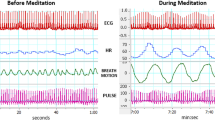Abstract
Transcutaneous electrical nerve stimulation (TENS) has been shown to have an anti-ischaemic effect in patients with angina and peripheral vascular disease that appears to be additional to any analgesic action. The mechanism for this antiischaemic effect is not known but it is possible that TENS interferes with the autonomic responses to ischaemia. To determine if TENS has any direct action on autonomic reflexes we have assessed the effect of high frequency TENS on a variety of standard tests of autonomic cardiovascular reflexes in 10 normal subjects. Tests were done on four consecutive days at the same time and TENS therapy or placebo was randomly allocated on 2 days each. Results of the tests were assessed by one person ‘blinded’ to the randomization order. These showed that TENS was associated with a significant reduction in the rise of the diastolic blood pressure (21.8 ± 2.3 v. 17.6 ± 17 mmHg; p < 0.05) during isometric exercise, using sustained Handgrip. There was no significant effect discernible on the changes of heart rate and blood pressure during the Valsalva manoeuvre, cold face stimulus or headup tilt. Transcutaneous electrical nerve stimulation appears, therefore, to have a mild inhibitory action on those reflexes mediated predominantly by the sympathetic nervous system and this is more apparent when the stimulation may be greater, as during isometric exercise.
Similar content being viewed by others
References
Melzack R, Wall PD. Pain mechanisms; a new theory.Science 1965;150: 971–9.
Wall PD, Sweet WH. Temporary abolition of pain in man.Science 1967;155: 108–9.
Mannheimer C, Carlsson C-A, Emanuelsson H, Verdin A, Waagstein F, Wilhelmsson C. The effects of transcutaneous electrical nerve stimulation in patients with severe angina pectoris.Circulation 1985;71: 308–16.
Johnson MI, Ashton CH, Thompson JW. Long term use of transcutaneous electrical nerve stimulation at New Castle Pain Relief Clinic.JR Soc Med 1992;85: 267–8.
Mannheimer C, Augustinsson L-E, Carlsson C-A, Manhem R, Wilhelmsson C. Epidural spinal electrical stimulation in severe angina pectoris.Br Heart J 1988;59: 56–61.
Sanderson JE, Brooksby P, Waterhouse D, Palmer RBG, Neubauer K. Epidural spinal electrical stimulation for severe angina, a study of its effects on symptoms, exercise tolerance and degree of ischaemia.Eur Heart J 1992;13: 628–33.
Sanderson JE, Ibrahim B, Waterhouse D, Palmer RBG. Spinal electrical stimulation for intractable angina — long term clinical outcome and safety.Eur Heart J 1994;15: 810–4.
Chauhan A, Mullins PA, Thuraisingham SI, Taylor G, Petch MC, Schofield PM. Effect of transcutaneous electrical nerve stimulation on coronary blood flow.Circulation 1994;89: 694–702.
Mannheimer C, Eliasson T, Anderson B, Bergh C-H, Augustinsson L-E, Emanuelsson H, Waagstein F. Effects of spinal cord stimulation in angina pectoris induced by pacing and possible mechanism of action.Br Med J 1993;307: 477–80.
Emanuelsson H, Mannheimer C, Waagstein F, Wilhelmsson C. Catecholamine metabolism during pacing-induced angina pectoris and the effect of transcutaneous electrical nerve stimulation.Am Heart J 1987;114: 1360–66.
Mannheimer C, Emanuelsson H, Waagstein F, Wilhelmsson C. Influence of Naloxone on the effects of high frequency transcutaneous electrical nerve stimulation in angina pectoris induced by atrial pacing.Br Heart J 1989;62: 36–42.
Kawakami Y, Natelson BH, Bubois A. Cardiovascular effects of face immersion and factors affecting the diving reflex in man.J Appl Physiol 1967;23: 964–970.
Levin AB. A simple test of cardiac function based upon the heart rate changes induced by the Valsalva maneuver.Am J Cardiol 1966;18: 90–9.
Freyschuss U. Cardiovascular adjustment to somatomotor activation.Acta Physiologica Scandinavica 1970;Suppl. 342: 1–63.
Ewing DJ, Clarke BF. Diagnosis and management of diabetic autonomic neuropathy.Br Med J 1982;285: 916–8.
Johnson MI, Hajela VK, Ashton CH, Thompson JW. The effects of auricular transcutaneous electrical nerve stimulation (TENS) on experimental pain threshold and autonomic function in healthy subjects.Pain 1991;46: 337–42.
Kaada B. Vasodilatation induced by transcutaneous nerve stimulation in peripheral ischaemia (Raynaud's Phenomena and diabetic polyneuropathy).Eur Heart J 1982;3: 303–7.
Han JS, Chen XH, Sun SL, Xu XJ, Yuan Y, Yan SC, Hao JX, Terenius L. Effect of low- and high-frequency TENS on ononet-enKeptalin-Arg-Phe and dynorphin A immunoreactivity in Luma lumbar CSF.Pain 1991;47: 295–8.
Cheng RS, Pomeranz B. Electroacupuncture analgesia could be mediated by at least two pain-relieving mechanisms: endorphin and non-endorphin systems.Life Sci 1979;25: 1957–62.
Basbaum AJ, Fields HI. Endogenous pain control mechanisms: review and hypothesis.Am Neurol 1978;4: 451–62.
Chandler MJ, Brennan TJ, Garrison DW, Kim KS, Schwartz PJ, Forman RD. A mechanism of cardiac pain suppression by spinal cord stimulation: implications for patients with angina pectoris.Eur Heart J 1993;14: 96–105.
Ueda H, Slimonura K, Goto H, Yasuda H, Ito K, Katayama S, Kuroina A, Sinimoto T. Change in coronary blood flow by stimulation of central nervous system.Jap Heart J 1964;5: 323–36.
de Jongste MJL, Haaksona J, Hautvast RWM, Hillege HL, Meyler PWJ, Staal MJ, Sanderson JE, Lie KL. Effects of spinal cord stimulation on daily life myocardial ischaemia in patients with severe coronary artery disease.Br Heart J 1994;71: 413–18.
Author information
Authors and Affiliations
Rights and permissions
About this article
Cite this article
Sanderson, J.E., Tomlinson, B., Lau, M.S.W. et al. The effect of transcutaneous electrical nerve stimulation (TENS) on autonomic cardiovascular reflexes. Clinical Autonomic Research 5, 81–84 (1995). https://doi.org/10.1007/BF01827467
Issue Date:
DOI: https://doi.org/10.1007/BF01827467




